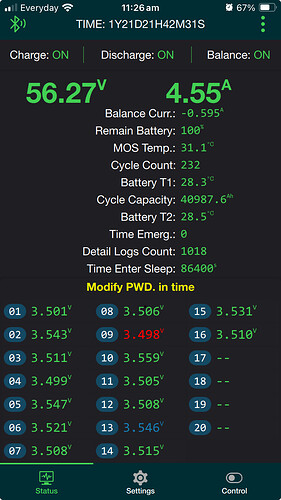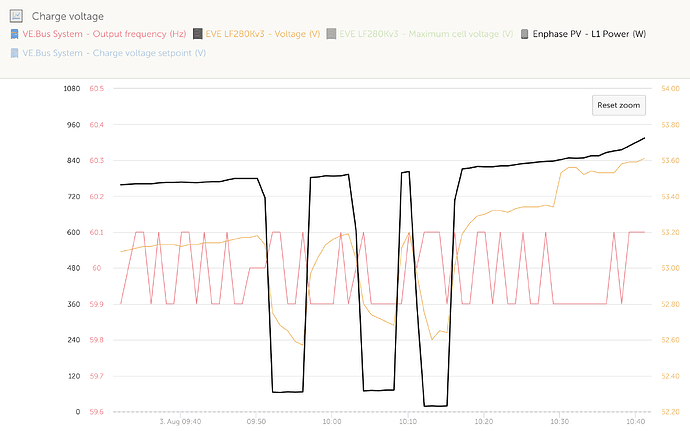Hi,
I’m having trouble charging my battery from 99% to 100% because my Quattro’s aren’t maintaining my requested absorption voltage when my Enphase PV microinverters are running (I’m using the PV assistant). Basically the battery voltage keeps rising until I hit a maximum cell voltage within the battery (the internal balancer can’t keep up) and the BMS then disables charging and then my Quattro freaks out with High DC Voltage alarms (the noises for which sound very not good for my victrons…).
My understanding is that the Quattro should start raising the output frequency on AC-Out once the battery hits 55.2v, thus lowering the Amps of AC from the microinverters, and allowing the battery to absorb the dwingling amps and balance itself. This isn’t happening. For example today I saw 56.81v while monitoring VRM and the output frequency was still 60.1Hz when in my understanding the Quattro’s should be telling the microinverters to slow down at least 1v earlier (my grid profile for the microinverters will shut off at 61.2Hz and theoretically limit after 60.1Hz). If I switch off the PV Inverters (via the circuit breaker) and turn on AC-In via circuit breaker (I have a 240V 20A connection to the grid for emergency charging) then it charges perfectly at 55.2V exactly as I would expect.
What am I misunderstanding in the situation?
My system details below:
I’ve got 2 Quattro 10k’s in split phase (USA) off grid setup. I’ve got a mix of DC and AC charging. DC with Smart Solar MPPT and AC with Enphase IQ8+ on AC Out of the Quattro’s. The battery system is DIY with a JK BMS and 48v LiFePO4 battery setup. Everything is connected with a rasbpi running VenusOS.
I’m using DVCC and BMS controlled charging so the requested charging voltage from the BMS is 55.2v (3.45v per cell) for 1 hour and then float at 53.6 (3.35v per cell). Now I’m not sure if the Quattro Charger settings from VE.Configure adhere to the BMS/DVCC settings but I also have that set to 55.2 for absorption.



